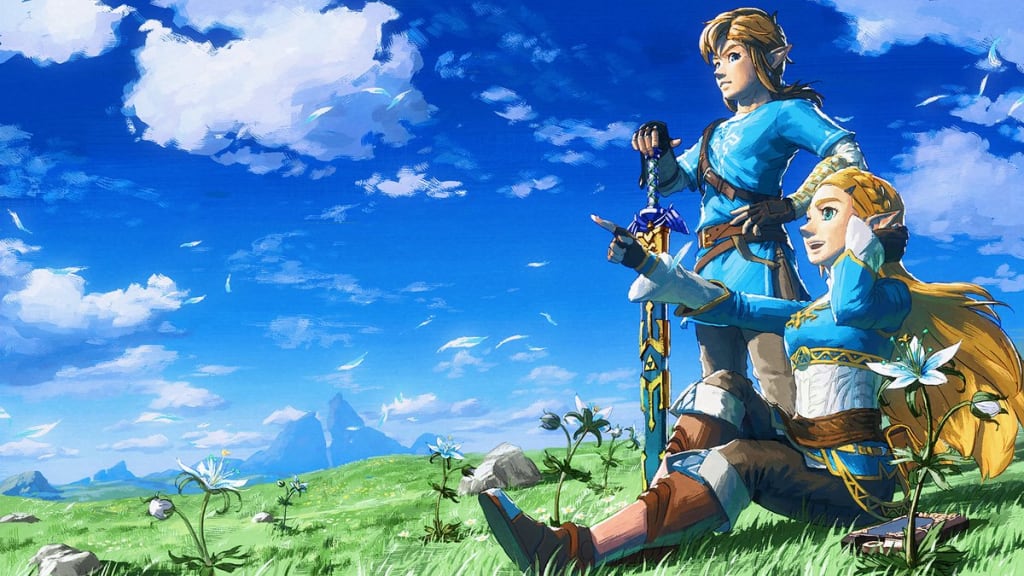'The Legend of Zelda: Breath of the Wild' Review
The best game of all time? Probably.

From the very moment I began playing the Legend of Zelda: Breath of the Wild, I knew that I was in for something special. I have played and owned well over three hundred video games throughout my life, and I have never had as much consistent fun with a game as this one. The opening moments of the game are pure gold, with constant momentum of discovery throughout the title’s relatively long duration. One of the beautiful things about Breath of the Wild is that there is no particular correct way to go about playing the game; it drops you into Hyrule, and just says “Go.” The direction you take Link in is entirely up to you.
“Freedom” in video games is a concept that I don’t think too many titles have truly captured before to such a degree of perfection that Breath has. The game cleverly hides its tutorial subconsciously throughout the opening zone, but it’s designed in a way so that you learn the basic mechanics of what the game has to offer without annoying you with constant barrages of hint text boxes. Yes, the game does present a few of them every now and then in the opening hours, but for the most part, it’s minimal and up to you. Nintendo has successfully crafted an open adventure that truly feels like what they were going for with the original NES Legend of Zelda, with a fully realized vision for their famous fantasy world. Nothing in Breath of the Wild feels incomplete. The level of polish on all of the aspects of the game seems nearly unprecedented in the industry, even if the game isn’t donning a hyper-realistic graphics engine.
Speaking of which, the game ran decently on the Wii U I played it on. The frame rate wasn’t perfect, which was truthfully the only flaw I can find presently in the game, as the hardware is rendering vast landscapes and details that are pushing the system to its limit. The fact is, the rest of the game is so good that this didn’t really bother me. There were a lot of inexcusable frame seizures every now and then when I was fighting the bigger mob enemies, and I will admit that it froze the screen for a few half seconds or so, but the game never froze on me altogether. If you can forgive that (which, trust me, you will, it’s just that good), the Wii U version is definitely functional. I currently do not own a Nintendo Switch, but it must be a fair assumption that the hardware is a little less limited on there. The game adopts a Studio Ghibli anime-esque art style, and it often reminded me of Princess Mononoke in its tone. And that’s a good thing.
The only other noticeable issue worth mentioning is that the game has only a single save file to play from. If you want to enjoy a second playthrough of the game, you’re going to have to delete your data, or buy a whole new system. It’s stupid. But the volume of content does somewhat justify this, as completing the game turns into somewhat of a commitment and I can’t see myself starting it over so quickly. If you live with multiple Zelda fans though, that’s another story altogether.
The plot in this game isn’t as detailed and grand as games like Twilight Princess or even Ocarina of Time, however, it is still enjoyable and I recommend going into it blind. Minimalism, once again, is a major aspect of the game in a lot of its design. The music is commonly short piano pieces that play at very natural moments when you’re out exploring the wilds of Hyrule, but the meatier themes in here are just as memorable. The game does not lack that indescribable Nintendo charm that you feel whenever you play one of their greats, but this is not a typical Zelda game. I spent almost 100 full hours before even touching the final boss, when I had the opportunity to fight it from the get-go. Yes, if you’re daring enough, it is possible to finish the game immediately after you start it. The beauty of the openness and modernized design of this Zelda adventure is that this story is really your own. While you are tasked with saving a ravaged Hyrule from a 100-year long calamity, you may easily find yourself sidetracked for dozens and dozens of hours just simply exploring parts of the map. The game is so well designed and compact that no area feels useless, and everything feels to be in just the right place.
Link has woken up from a 100-year long coma with no memory of the Great Calamity, and Zelda needs saving. It’s somewhat typical. But the game takes many of the conventions of past games, and almost completely throws most of them away. Weapons break. The green tunic is noticeably absent. There are only four dungeons. Everything is optional. You don’t regain hearts by finding them in cut grass, but rather you eat and cook food to regain them. Link has a stamina wheel (similar to Skyward Sword) that allows him to sprint for a certain amount of time, and it (as well as the hearts) can be extended. One of the best feelings I had in this game was the character progression. In many ways, I feel as if Breath is somewhat of an unconventional RPG and unconventional 3D platformer hybrid, but it creates something unique. Traversal is incredible, as almost every surface in all of Hyrule can be climbed now, and if you go about the game by trying to power Link up as much as possible, you truly feel a sense of raw power and built up skills from so much dedicated time with the game’s mechanics combined with the rewards you reap to increase his stats.
This is one of the game’s best aspects. I felt like I was familiar with its concepts enough to the point where I entered a subconscious state of gaming bliss. There’s a real feeling of growth you have with this game, and it’s not reinforced simply due to the illusion of gaining more health and whatnot. Games get compared to Dark Souls all the time these days, and while I can actually feel some extremely subtle design elements from those kinds of games in here, this game is a fair and fun kind of difficult. Whenever I planned to play it for maybe an hour in the afternoon, the sun would be long gone by the time I switched off my console.
Exploration is an absolute treat in Breath of the Wild. So many times I backtracked to old areas I thought I memorized, but then looked at things from a different angle and realized I missed so much. This Hyrule is overwhelming at first, but at about the fifty hour mark, it still felt massive, but not nearly as daunting. At this point I feel I have the map somewhat memorized. Breath presents you with a blank map at the start, and it’s up to you to climb many very high towers in Hyrule in order to fill it up. I loved doing this, and I was actually saddened to climb my final tower to complete my map, as there was less mystery. Thankfully, the game has another timesink in the form of Shrines.
Think of Shrines as mini-dungeons. Some are brief battles with recycled, albeit fun, enemies, some require so many prerequisites just to find them that the actual Shrine simply presents you with a reward for finding it, but the best ones are the puzzles (think the test rooms in the Portal games, but with Breath of the Wild’s impressive physics and mechanics). There are 120 shrines in all, and completing each one not only grants you a fast travel location, but a collectible to extend your health or stamina. Finding all of them is a challenge, and there are plenty of sidequests to keep you busy after that.
I genuinely had tears trying to escape my eyes after completing this game, because even with my prolonged playtime, I didn’t want it to end. My adventure consisted of completing all of the dungeons and main objectives first (besides the final boss), and mass exploration across Hyrule to find all of its Shrines. I will admit I consulted the internet to find my last few, but I found over 100 of them on my own, and it felt incredibly satisfying. The game also has a complex “chemistry” mechanic in its physics engine that allows you to do things like burning wood and flammable objects, affecting things with momentum and storing up kinetic energy, as well as a dynamic weather system. No two people will EVER play this game the same way.
It still feels like a Zelda game, but it feels evolved. Past games had to work around hardware constraints to deliver the illusion of a big world, but this world truly is big, no smoke and mirrors. I think that some people may find some of the aspects of the game that do not resemble past Zelda's a bit jarring, but they will surely come to appreciate it quickly.
Over about the last twenty years, the franchise has had endless debates between Ocarina of Time versus A Link to the Past. I don’t think it’s far off to say that this will be thrown in that ring as well. There is something for absolutely everyone in this game, and every sitting feels like the most fun I’ve ever had in a video game. We’re going to need to wait until the dust settles to see where this game truly sits among the vast pantheon of older titles in the franchise, but The Legend of Zelda: Breath of the Wild feels like the Zelda game we’ve truly been waiting for. In my opinion, it is the best game Nintendo has ever made, and my new favorite game of all time. The DLC is spectacular as well, and if you enjoy your initial playthrough, it's more of the same, but well worth the twenty dollar entry fee.
10/10
About the Creator
Kevin Resnick
3D Artist and Illustrator based in Chicago, IL. Passionate about video games and media, and lover of storytelling.







Comments
There are no comments for this story
Be the first to respond and start the conversation.